(A) The steel strengthening brackets
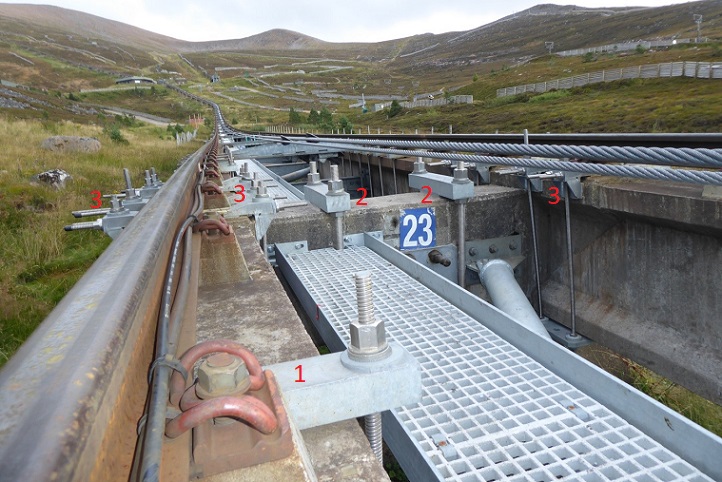
This picture shows the three different types of bracket used in the strengthening works.
I have labelled these:-
Type 1. The bracket in the foreground (used in the central section of the “I” beam
Type 2. The brackets around the insitu block either side of the number 23
Type 3. The brackets around the scarf joint, more clearly seen on the right of the next picture.
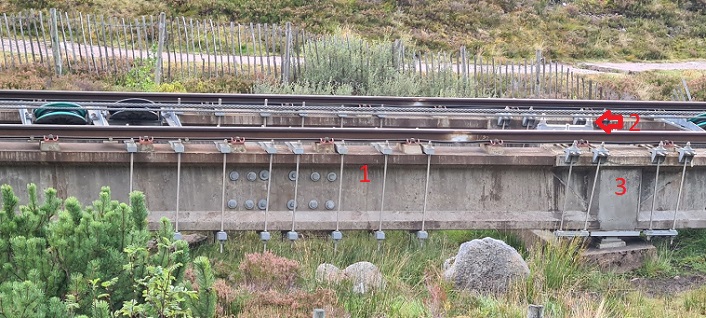
As far as I can determine from surveys taken in January and February 2023 the following number of brackets have been added to the funicular structure:
Type 1… no. 917;
Type 2… no. 179;
Type 3… no. 333.
Total … no 1429.
TYPE 1.
126 of the 188 “I” beams have no type 1 brackets. All the other beams, just less than 1/3rd, have at least 7 brackets, while some at the passing loop half way along the railway have as many as 25!!! Why? The ADAC Structures reports mentioned poor quality control in the manufacture of the “I” beams but if that was the explanation why are just over 2/3rds of the “I” beams apparently ok?
Between piers 51 to 57, the passing loop, there are 19 beams and 355 brackets, an average of over 18 per “I” beam and 38% of the total number fitted. That’s not poor quality control, it is proof that there is a significant structural issue with the passing loop which has not being acknowledged in any report I have seen.
Compare this picture of the “I” beams at the passing loop (note the 4 bolt pattern) pre-repair work, courtesy of LECS UK who approved the re-opening of the funicular,
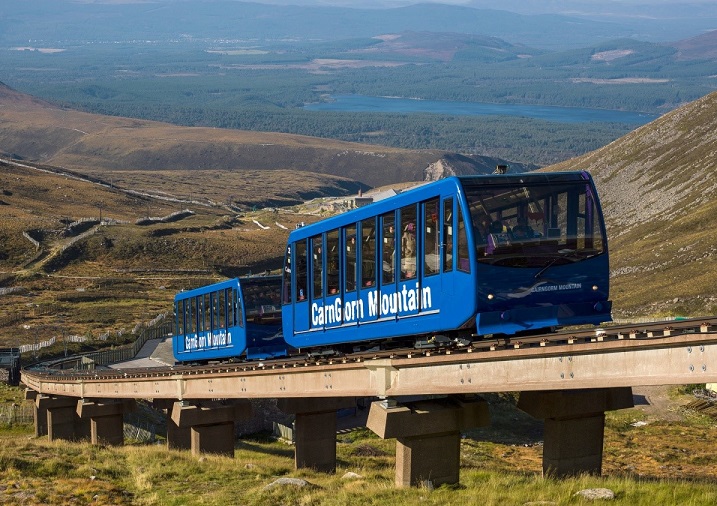
with this next one taken in September 2023:

That is a massive quantity of steelwork that has been added.
Apart from the passing loop the majority of the other Type 1 brackets are where there are changes in stresses acting on the track e.g. where the track curves, changes in elevation, etc.
TYPE 2.
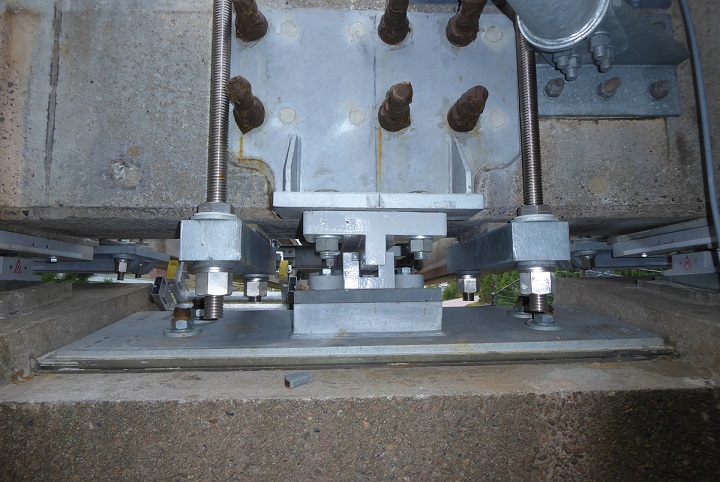
All the in-situ joints, apart from the anchor blocks, have at least two Type 2 brackets whose purpose appears to be to strengthen the block around the new central bearings that have been fitted.
TYPE 3.
Every scarf joint, except those at the 6 anchor blocks and on piers 51, 52, 55, 56 and 57 which have been reconstructed, are fitted with a Type 3 bracket. As I have explained before (see here), these brackets are being used to compensate for the lack of steel support under the weakest part of the “I” beams, the sloping ends, but it appears that their use has created more problems!
HIE have admitted that there are tensioning issues at the scarf joints, i.e with the Type 3 brackets, and after a conversation with a civil engineer I will now offer an explanation.
(1) Torque and Tension
This explanation is from the Rimex blog (see here):

If the tension was found to be too low when the brackets were first fitted around the funicular structure, then increasing the torque will increase the tension. But what this also explains is that if a nut has been slackened off or vibrated loose it requires more torque, i.e turning of a spanner, to attain the same initial amount of tension in the studding. There is, however, a point at which the studding will start to stretch and eventually snap!
(2) The effects of temperature?
(a) If a nut is torqued to a specific setting on a hot day as the temperature drops the studding will contract INCREASING the tension. Thiscould cause the brackets to crush the concrete that they are supposed to be strengthening!
(b) If a nut is torqued to the same setting on a cold day, as the temperature increases the studding will expand DECREASING the tension.
IT’S A NO WIN SITUATION.
(3) Poor working practices!
Anyone who has replaced the cylinder head on an engine will know that the cylinder head bolts have a tightening sequence AND gradually increasing torque settings. The reason for this is to ensure even loading on all parts of the cylinder head. The same applies to the brackets on the “I” beams and the insitu blocks but are even more critical on the type 3 brackets fitted to the scarf joints because there are four lengths of studding as opposed to two. One corner could be putting excessive force onto the concrete at that point. Is that what has happened here?
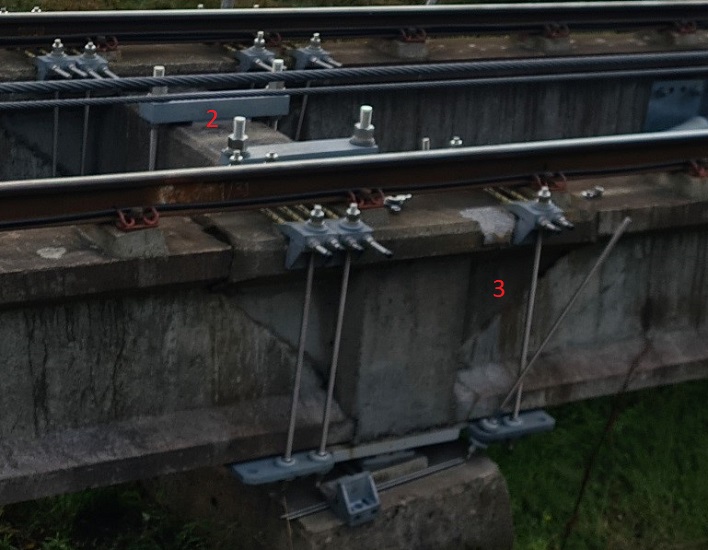
(4) Heat dissipation.
Stainless steel is one of the worst metals I have ever worked with. Because it has a very low rate of heat transfer, as you tighten and even slacken a nut the heat generated can fuse/ weld the threads of the nut and the studding together giving a false indication of torque, although this should be picked up IF THE TENSION ON EVERY STUD IS CHECKED!
If there is one recurring theme discussed in reports and documents over the lifetime of the funicular it is poor maintenance and repairs.
Even with the current repair work there are more issues.
(B) The two types of ABS plastic caps.
The following picture shows one type of cap as fitted to what I have labeled as a type 3 or scarf joint bracket.
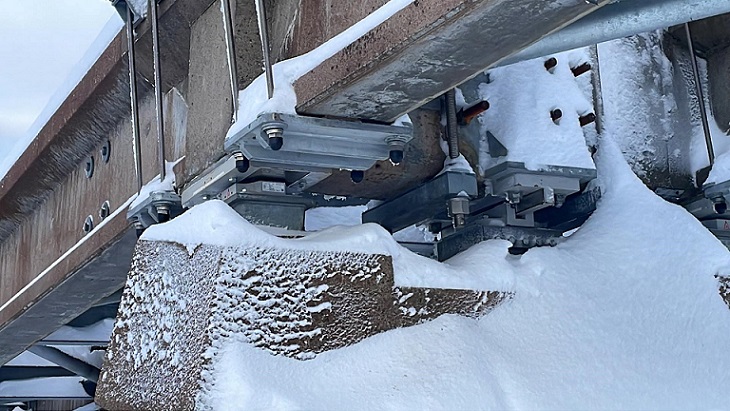 This cap actually has a specific purpose as described here:.
This cap actually has a specific purpose as described here:.

It is used to stop the ingress of water into the threads of the nut/ studding interface which reduces corrosion. The positioning of the caps should therefore have been on the top of all vertical studding NOT the bottom.
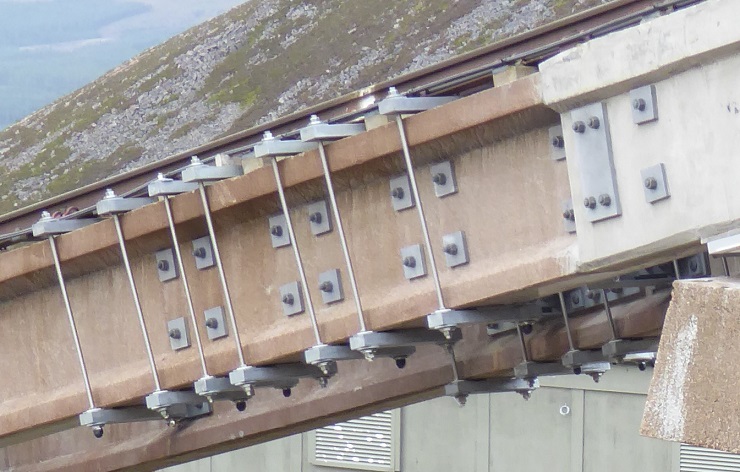
How many times in the past have we been told about poor workmanship and quality control (see photo above and below)? Did someone not carry enough plastic caps to do the job and forgot to get and fit the extra ones? Has nothing been learned from past mistakes? Apparently not.
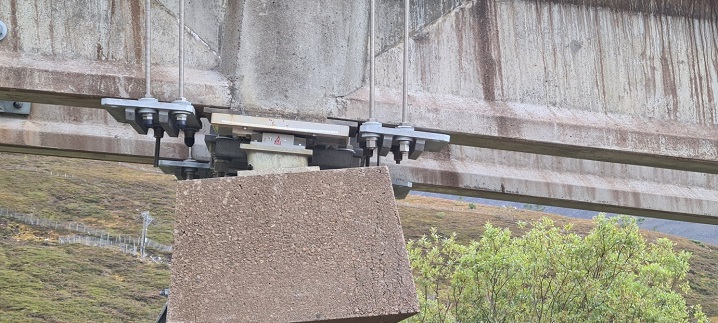
The second type of covering is a plastic tube used to prevent damage to the studding threads and injury to people and should therefore be fitted as a safety precaution to EVERY piece of studding (see here):

And what about this close up from the top-most photo as another example of poor workmanship/ quality control as well as a H & S risk?
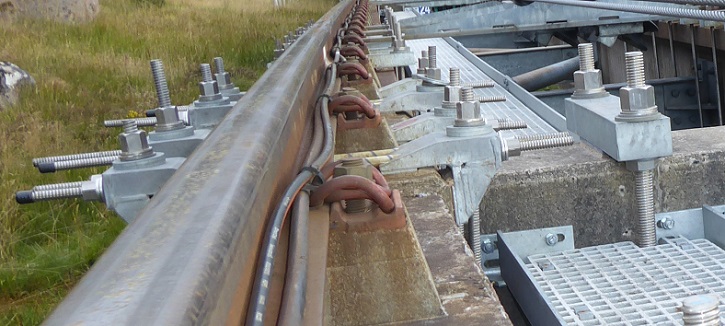
Exposed studding with no protective covering or “Tripping Hazard” warning signs just waiting for a moments lapse in concentration by maintenance staff on the new walkway! All excess lengths of studding should have been cut to less than one nut length above/ beyond the nut. Or a better idea, why not order the correct length in the first place instead of paying for material that is not needed?
Conclusion
In a series of PW posts I asked the question “Will the repair of the Cairngorm funicular work?” and at that time concluded that they would. I was wrong. If the repairs had worked then we wouldn’t be in this situation now, the funicular closed and with no definite re-opening date.
Is the problem so bad that without more major work costing £??M the funicular may not open for this ski season? Nobody knows because as usual HIE aren’t saying.
Postscript
I would like to thank everyone who has commented on my posts including the criticisms without which we can’t have an informed discussion. I would in particular like to thank those civil engineers who I have spoken to on the phone. Your help has been invaluable. I hope everyone is having a happy Xmas and a Happy New Year to you all.

An excellent summary of the current situation. If this was seen by any of our European engineering friends they would be in utter disbelief. None of these problems would have occurred if the structure had been steel as originally proposed. The capital cost and the resultant loss of revenue over the years needs to be the subject of public enquiry and those responsible must held to account.
I took my 2 Thai nieces to Aviemore a few years ago and they loved the railway and the snow at the top.
We went to Scotland to see the snow etc. Without the railway we probably would not have gone.
Think positive and for the future. Resorts need attractions to succeed.. Heaven forbid the it will not reopen
The other option is telecabine of some description. Many years ago now my brother took his two when quite young (under five for the youngest from memory) to Glencoe and Nevis Range at my suggestion rather than their normal summer trip up Cairngorm on the train. The feedback I got was they preferred Glencoe out of all of them. Make of that what you want, but clearly, a train is not a prerequisite for taking small children up a mountain.
Slightly surprised something under so much tension doesn’t have a lock nut but it’s a bit outside my field. Checking those each year will be like painting the Forth Bridge. There must be funding allocated for this annually.
Again a real shame. Quite embarrassing really! Its a funicular railway; a tried and tested piece of engineering. There are plenty of them in the alps and they are running sweetly. No doubt another case of giving the project to the cheapest quotation, which has to cut corners to keep the unrealistic costs down. The outcome is always the same – poor workmanship that leads to eventual over spending to rectify shoddy workmanship, that could of been done properly with a competent workforce at the first attempt. I hope it gets sorted, if not; get something in place that works!
As an engineer I would say on looking at your pictures that the fitments you show look no more than some attempt at manufacture of a cheap glorified clamp that I would say does nothing of benefit in the configurations shown . The screwed rods and metal clamp parts are just acting like G clamps and no way can you get an accurate torque setting on any of them in the current set up . It looks like a quick botch up repair that has no real design or longevity about it.The screwed rods have probably all just been horsed up with a spanner by numerous fitters . Somebody has had the wool pulled over their eyes on this repair solution and no doubt paid a lot of money for it .
Why not encourage skiers to walk up on “skins”? It’s called ski mountaineering,is fast growing in Europe & North America. Uses a releasable heel with artificial skins that stick to bottom of skis reduving slip back, essentially you walk up hill; take the off the skins after the ascent then ski down; then heel fastened for alpine descent, free heel for for proper skiers -telemarkers. It is eco friendly, healthy, fun and would attract people who do not want expensive, ugly, noisy, mechanised & carbon poor means of easy ascent. At least have separte ascent tracks marked THAT COULS BE DONE (& ADVERTISED) THIS SEASON AT LOW COST! Even older people can do it (I am 70).
I think the funicular does not exist just for the benefit of skiers, but for anybody all year round. Despite the possibility of skinning up, a lot of skiers would be deterred if that was the only option. For Cairngorm to be a success it needs to attract people.
Cairngorm is already over run by ski tourers (I being one of them). Whilst it is a great way to access the hill, there is limited room during most of the ‘marginal’ snow conditions we get here and more significantly, ski touring is out of the scope of most people’s abilities (sadly). I do however think that CG could do more to capitalise on the increasing popularity of touring.
It amazes me that all that so much money has been spent to basically create more problems. Other countries have ski-resorts which all operate well and good. I wonder if any of those contractors were contacted to bid for the work. How can we be a country who maintains something like the fourth rail bridge, yet cannot manage to maintain this?
The Funicular, Rest and Be Thankful, A82, A 9, another list of transport failures from the Scottish Government, anywhere else, been done and dusted years ago.
The planning for the funicular began before the Scottish Government existed in fairness.
Come on can’t blame the Scottish government for piss poor workmanship by original contracter.
Wether they excepted the cheapest option or not it still should have been finished to a certain standard. This falls smack bang at the contracters front door, not the Scottish government’s door.
Now I’m not saying that they are blame free but they were not the company that was installing the railway.
HIE got millions of compensation for the utter fuck up. Where have they spent all those millions. They need to answer questions regarding this money as it should have been spent on the railway.
Let’s park the argument about the original design and build of the funicular for now. Having got to the point of having to close the funicular back in 2018, what needs to be examined is:
– the process by which HIE got approval to spend £16M on repairs, which ended up costing £25M…and counting
– how the repair design was developed and approved
– what inspection of workmanship was carried out on the repairs
– what do HIE/CMSL believe they intend to achieve via the 5 month and counting so-called ‘snagging’ repairs
– what engineering reports were produced before this ‘snagging’ work commenced.
– the process by which the funicular was given approval to go back into service in January 2023
If HIE, CMSL and the Scottish Government are going to hide behind bad design and/or workmanship, then lets see all the evidence. For me the small amount of evidence we have points to HIE, CMSL and the Scottish Government being incompetent and negligent in their approval process and management of virtually everything connected with the attempts to repair the funicular since its closure in 2018.
I have been always following the funicular saga.
I refuse to believe that it was designed by idiots and is run by idiots. I love Cairngorms and I am a frequent visitor since 1971. I am an old man and it would be nice to have the funicular.
More than on one occasion I overheard a pub conversation very much against the funicular , massive tourism and skiing. Scotland is for hunting or golf. I believe that the funicular has not too many friends among local gentry, local authority and in particular environment protection people. I guess it might be the reason of the funicular problems.
Yes, I think that is the crux of it.
I totally agree. Why cant the British engineering which was used to the rail system in Wengen used?
Mr.D Bennett
Quite so. There are numerous Alpine railways operating successfully for many years.
Surely the construction method/process should have replicated the Alpine proven design
I agree with John (December 28, 2023 at 11:56 am) that the mess of brackets and clamps are very unlikely to resolve the root cause of the fundamental design failure. The main support beams had to be structurally merged (encastred) to convert them from simply supported beams to a continuous rigid beam across the support pillars. The strange trapezoidal RC connecting features between the beams are not fit purpose. This has left excess beam deflections at mid span and slope discontinuities over the support pillars. To expect the crude clamping devices to correct such a fundamental failure beggars belief. Recovering a safety case for this mess at any sane cost is surely very implausible.
I have had similar observations from another expert civil engineer. “The strange trapezoidal RC connecting features”! The ends of a number, exactly how many not known, of those rebars were fully welded thereby altering the tensile properties of the rebar, effectively returning it to its mild steel status with all that heat. The reports and design of the repair/ strengthening works were all by well known and respected engineering companies which begs the question What was the briefing?
You can’t polish a turd…
Desktop calculations may have shown this to be a solution. However, there are so many variables here: failing pre cast structures, dynamic loads, multiple clamping forces which are all inter – dependent on each other and subject to the vagaries of extreme temperatures. Its all been set – out in embarrassing detail…
If they cannot get this lot fitted, torqued – up and working … and signed off by the relevant authorities in the time they’ve already had, it does not bode well for the future. So, if they ever get the train running again – for how long? As others have pointed out the original design and execution was fatally flawed from the outset . This can only be buying a very short period of time at best, it will be maintenance hell until its finally condemned. Perhaps enough time for the HIE Board to reach for their pensions?
I feel very sorry for the staff on Cairngorm but any short term fix is only kicking the can down the road
Looking at the photographs of the new multiple types of brackets & clamping arrangements working along with the new precast concrete beams, all having to bear onto the original foundations – this creates an indeterminate structure. It is now likely that the many parts of the railway structure are just not behaving as the designers intended. With this new Heath-Robinson detailing and the inherent faults discussed above, it may be nigh impossible to ever return this facility back into long-term service. I believe the £25m re-design/refurbishment should have required more improvements on the foundations.